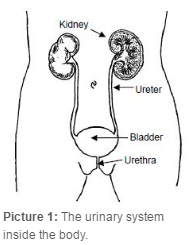IVP (Intravenous Pyelogram)
![]()
The purpose of an Intravenous Pyelogram (in-tra-VEE-nus PIE-lo-gram), or IVP, is to look at the size and function of the kidneys and urinary tract (Picture 1).
This is done by injecting contrast (dye) into your child’s vein and then taking X-rays of the kidneys.
How to Prepare for the Test

- Explain to your child what will happen during the test in a way that he or she can understand. Your child should wear a T-shirt and sweat pants for this test. He or she may have to change into a hospital gown if other clothes are worn.
- A child under 2 years of age should not have any food or water for 4 hours before the test is scheduled.
- A child 2 years of age and older should not have anything to eat or drink after 12:00 midnight if the test is scheduled for the morning. If the test will be after 12:00 noon, your child should have nothing to eat or drink for 6 hours before the test.
- Be sure to tell the technologist (X-ray tech) if you think you or your child may be pregnant.
- Be sure to tell the X-ray tech if your child is a diabetic and takes metformin (Glucophage®).
How the Test Is Done

-
You may stay with your child during the test.
-
Your child will lie on a long table with a large camera over it (Picture 2). The camera will not touch or hurt him.
-
A nurse will put a small needle into a vein in your child's arm or foot. Your child will feel a little sting, but not for very long. A clear liquid called contrast will be put into the vein.
-
Your child may get a warm feeling throughout the body and a “metal taste” in the mouth when the contrast is given. This is normal and will go away.
-
The contrast contains iodine. It flows through the blood vessels throughout the body. It then
-
goes into the urinary system and makes the kidneys, ureters and bladder show up on the X-ray film.
-
The X-ray tech will start the exam by taking an X-ray of your child’s abdomen (belly). While the X-rays are being taken, you will hear a beep from the camera.
-
After the contrast is injected, the X-ray tech will take a series of X-rays as he or she watches for the contrast to flow through the urinary system.
-
The amount of time the test will take depends on how fast the contrast is able to flow through the body.
-
The X-ray tech will speak with the radiologist to make sure everything that is needed can be seen on the X-rays.
-
When the radiologist is satisfied with the images, the X-ray tech will take your child to the restroom.
-
If a child is on clean intermittent catheterization, the bladder will be catheterized at some point while the X-rays are being done.
-
After your child has emptied his bladder, the X-ray tech will take one more X-ray.
After the Test
-
Your child may eat his usual foods and return to normal play.
-
When the X-ray results are ready (usually 24 to 48 hours after the test), your child’s doctor will explain the test results to you.
If you have any questions about your child’s test, please call the Department of Radiology at (614) 722-2350.
HH-III-11 10/75, Revised 8/15 Copyright 1975, Nationwide Children’s Hospital
